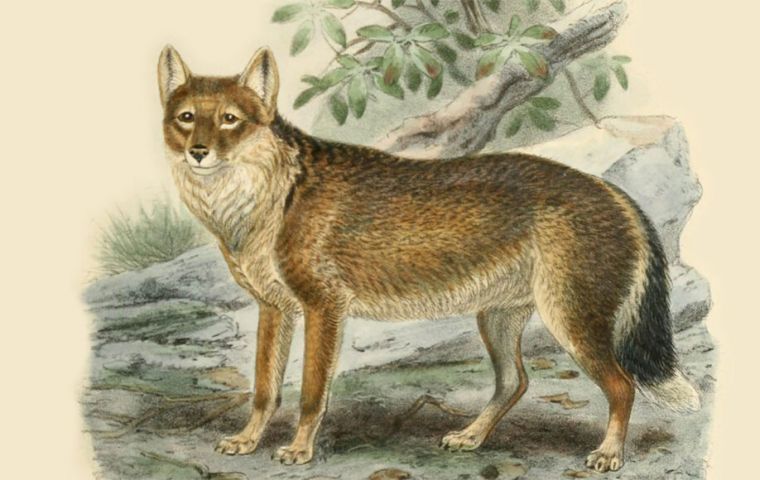MercoPress. South Atlantic News Agency
Closer to solving the mystery of the extinct Falklands' canid warrah
 The enigmatic, now-extinct Falkland Islands wolf had human visitors on the remote archipelago up to 1,070 years ago
The enigmatic, now-extinct Falkland Islands wolf had human visitors on the remote archipelago up to 1,070 years ago The team headed by Kit Hamley also extended its research into the warrah (Dusicyon australis), an extinct species of fox. The warrah was the only native and terrestrial mammal to reside on the Falkland Islands at the time of European arrival. Subsequent hunting wiped the species out in 1856, making it the first extinct canid in the historic record, Hamley says.
For years, various scholars, including Charles Darwin, have debated the warrah's origins and how it came to the Islands. Hamley hypothesizes that humans may have introduced the species to the archipelago before European settlement. Many previously rejected the theory based on a prior lack of scientific evidence, but the latest findings from Hamley's team reopens that possibility, she says. Indigenous South Americans may have domesticated warrah as they have with other foxes and canids, and brought them to the Islands during their voyages and short-term stays.
During a 2018 expedition to the Islands, Hamely and her colleagues found three warrah bone samples at Spring Point Farm in West Falkland. Carbon dating and isotopic analysis revealed the warrah whose bones were analyzed “had a marine-based diet consisting primarily of apex marine predators” like sea lions and fur seals, a similar diet to seafaring Indigenous South Americans in prehistoric times, according to researchers. While these findings could reflect coastal scavenging, it may exemplify the food their potential human counterparts were procuring and eating, researchers say.
“This study has the potential to change the trajectory of future ecological research in The Falklands,” says Hamley. “The introduction of a top predator, like the warrah, could have had profound implications for the biodiversity of the Islands, which are home to ground-nesting seabirds such as penguins, albatross and cormorants. It also changes the ever-captivating story of past human-canine relationships. We know that Indigenous South Americans domesticated foxes, but this study helps show how potentially important these animals were to those communities extending back thousands of years.”
Hamley conducted her research during three expeditions to the Falkland Islands in 2014, 2016 and 2018. During the 2016 journey, she participated in UMaine's Follow a Researcher program, through which scientists give K–12 students a glimpse of their work through live expedition updates, Twitter chats and videos.
The study led by Hamley contributes to the growing body of scientific investigations into the ecological, anthropological and climate history of the Falklands Islands conducted by UMaine researchers. A 2020 UMaine-led study discovered that the establishment of seabird colonies on the Islands in response to an abrupt regional cooling period 5,000 years ago changed its ecosystems.
“As the world warms, we hope our growing understanding of the pre-colonial history of the Falklands will help decision-makers balance the needs of wildlife and people, who rely on ecotourism, fisheries and other industries,” says Gill, an NSF CAREER researcher who was named a 2020 Friend of the Planet by the National Center for Science Education. “We're only just beginning to piece together the role people played in the Falklands before European settlement. Because of centuries of colonialism on the mainland, a lot of the oral knowledge about this period was lost. Western science needs updating, and we hope future work will be done in collaboration with the modern-day Indigenous people in the region; their ancestors were the first experts here.”




Top Comments
Disclaimer & comment rules-

-

-

Read all commentsI believe there are five warrahs (complete and partial) preserved around the world - one of which is in a museum in Brussels. Did Harmley also research the Belgian warrah and others to compare DNA?
Oct 28th, 2021 - 10:02 am 0There is also one in the Natural History Museum in London. As well as a large collection in the museum in Stanley. It is hardly surprising that its diet consisted of sea lions and seals, the warrah would have been carnivorous and before we populated the islands there were no other land mammals. Except, perhaps, the Patagonian Fox.
Oct 29th, 2021 - 08:39 am 0A DNA analysis could reveal how close they were to Patagonian Foxes and maybe even how long they had been separated.
Oct 29th, 2021 - 09:45 pm -1Doesn’t look like they got any usable DNA samples.
Question now is what the implications for the biodiversity of the Islands are having removed a top predator.
Commenting for this story is now closed.
If you have a Facebook account, become a fan and comment on our Facebook Page!